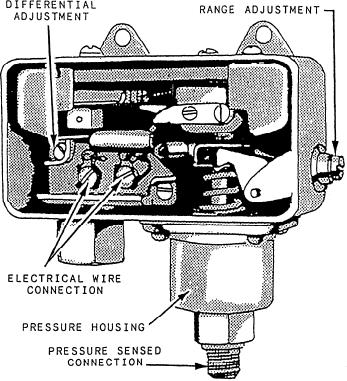
CHAPTER 6
PRESSURE, TEMPERATURE, AND LEVEL CONTROL
DEVICES
The consoles on board gas turbine-powered ships
monitor and control various systems and equipment.
These systems are monitored with pressure,
temperature, and level gauges and meters. Control
d e v i c e s are used to accomplish the monitoring
functions. Control devices also generate the alarms that
are displayed on the consoles. A control device, in its
simplest form, is an electrical switching device that
applies voltage to or removes voltage from a single load.
In more complex systems, the initial device may set into
action other control devices that govern pressures,
temperatures, and liquid levels.
In this chapter we will describe the different control
devices that you, the GS, must troubleshoot and repair.
These include pressure, temperature, and level control
devices. Upon completion of this chapter, you should be
able to describe the types of control devices used on gas
turbine-powered ships and their basic maintenance
procedures.
PRESSURE CONTROL DEVICES
Figure 6-1.--Typical pressure switch.
Pressure is one of the basic engineering
measurements that must be monitored aboard ship.
P r e s s u r e control devices control the operation of
alarm to sound, or a piece of equipment to stop or start.
equipment. They stop and start motors, cycle ventilation
The switch is normally enclosed in a metal case with a
dampers, and generate low- and high-pressure alarms to
removable cover. The metal case provides a pressure
the propulsion control systems. Pressure control devices
port and an electrical connection point. A pressure
include pressure switches and pressure transducers.
switch converts pressure energy into electrical energy.
Pressure readings provided by these devices will allow
Pressure switches are used on pneumatic and hydraulic
you to determine the operating condition of your
systems. The shapes, configurations, and sizes of
equipment.
pressure switches may differ but the functions basically
the same. The type of switch used depends upon its
PRESSURE SWITCHES
application.
A pressure switch opens or closes a set of contacts
at a preset pressure. Pressure switches can provide alarm
Construction
indication or start an action, such as stopping an air
compressor at a preset pressure. A typical pressure
Pressure-operated switches are normally
switch is shown in figure 6-1.
single-pole, single-throw, quick-acting switches. An
individual pressure switch contains either a bellows or
The operation of the pressure switch is simple.
W h e n the pressure reaches the preset value, the
a diaphragm that works against an adjustable spring.
The spring causes the electrical contacts to open or close
pressure-sensing mechanism operates. The actuation of
automatically when the operating pressure rises or falls
the sensing mechanism causes a light to illuminate, an
6-1

